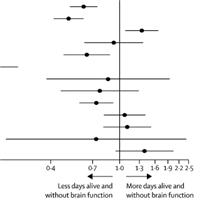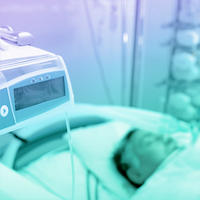Tag: coma

Acute Traumatic Coma Awakening by Right Median Nerve Electrical Stimulation
Severe traumatic brain injury (TBI) leads to acute coma and may result in prolonged disorder of consciousness (pDOC). We aimed to determine whether right median nerve electrical stimulation is a safe and effective treatment... read more

Blood-Pressure Targets in Comatose Survivors of Cardiac Arrest
Targeting a mean arterial blood pressure of 77 mm Hg or 63 mm Hg in patients who had been resuscitated from cardiac arrest did not result in significantly different percentages of patients dying or having severe disability... read more

Melatonin in ICU Delirium: Shining Light on the Hormone of Darkness
Delirium represents a form of acute brain dysfunction predictive of excess death and long-term cognitive impairment in critically ill patients. For many years, we have wondered whether pharmacological doses of melatonin would... read more

Delirium Incidence, Duration, and Severity in Critically Ill Patients with COVID-19
Delirium without coma occurred in 29.1% of patients admitted to the ICU. Delirium persisted for a median of 5 days and was severe. Mechanical ventilation was significantly associated with odds of delirium even after adjustment... read more

Delirium Prevalence and Risk Factors for Critically Ill COVID-19 Patients
Acute brain dysfunction was highly prevalent and prolonged in critically ill patients with COVID-19. Benzodiazepine use and lack of family visitation were identified as modifiable risk factors for delirium, and thus these... read more

Response to optic nerve sheath diameter guided detection of sepsis associated encephalopathy
regarding the blind method, being uninformed of the clinical diagnoses of patients is unavailing, since clues will still be found in patients' clinical manifestations. Therefore, two trained physicians in intensive ultrasound... read more

Targeted Temperature Management for Cardiac Arrest with Nonshockable Rhythm
Among patients with coma who had been resuscitated from cardiac arrest with nonshockable rhythm, moderate therapeutic hypothermia at 33°C for 24 hours led to a higher percentage of patients who survived with a favorable... read more

Inter-Rater Reliability Between PICU Nurses Performing a Modification to the Glasgow Coma Scale
The objective of this study was to estimate the inter-rater reliability of critical care nurses performing a pediatric modification of the Glasgow Coma Scale in a contemporary pediatric intensive care unit (PICU). All... read more

Last Year, The Flu Put Him In A Coma. This Year He’s Getting The Shot
Charlie Hinderliter wasn't opposed to the flu shot. He didn't have a problem with vaccinations. He was one of about 53 percent of Americans who just don't get one. An estimated 80,000 Americans died of the flu, or flu-related... read more

The Effect of a Quality Improvement Intervention on Perceived Sleep Quality and Cognition in the ICU
An ICU-wide quality improvement intervention to improve sleep and delirium is feasible and associated with significant improvements in perceived nighttime noise, incidence of delirium/coma, and daily delirium/coma-free status.... read more

Extended ICU Visitation Model Reduces Delirium
In this medical-surgical ICU, an extended visitation model was associated with reduced occurrence of delirium and shorter length of delirium/coma and ICU stay. Two hundred eighty-six patients were enrolled (141 restricted... read more

Early EEG for outcome prediction of postanoxic coma
We recently showed that electroencephalography (EEG) patterns within the first 24 hours robustly contribute to multimodal prediction of poor or good neurological outcome of comatose patients after cardiac arrest. Here, we... read more
Coma with Eelco Wijdicks – Podcast
So you have an unresponsive patient. The CT is negative. What now? Coma is tough! The differential is long and filled with many life threats.... read more




